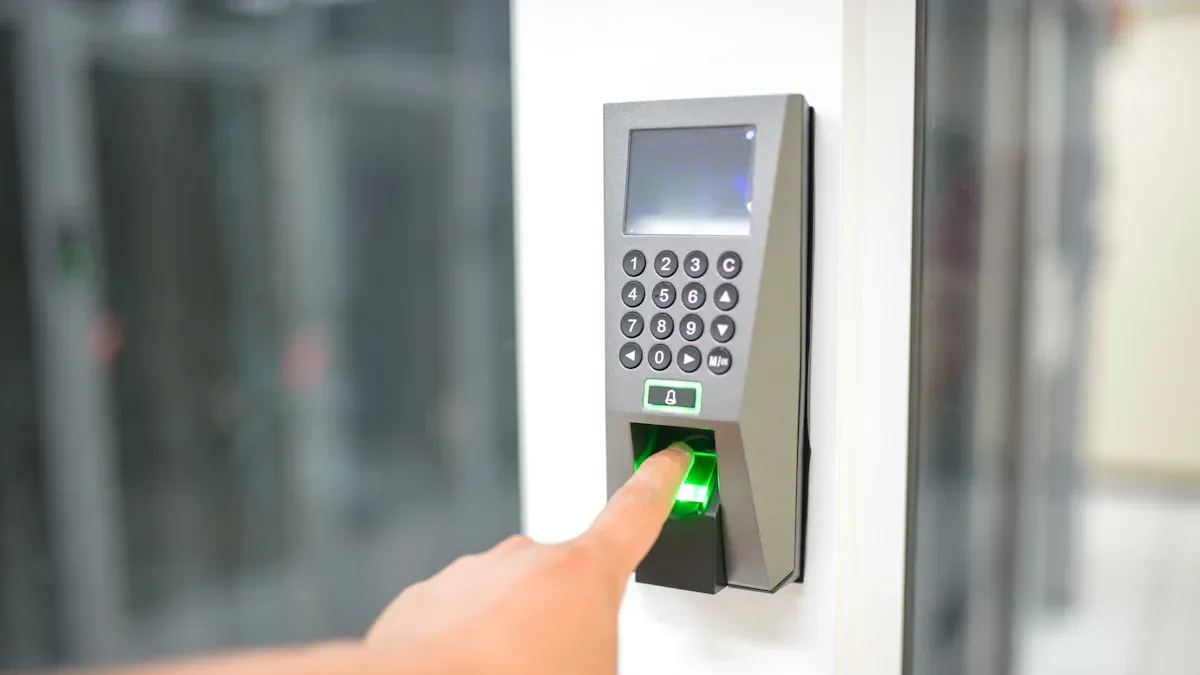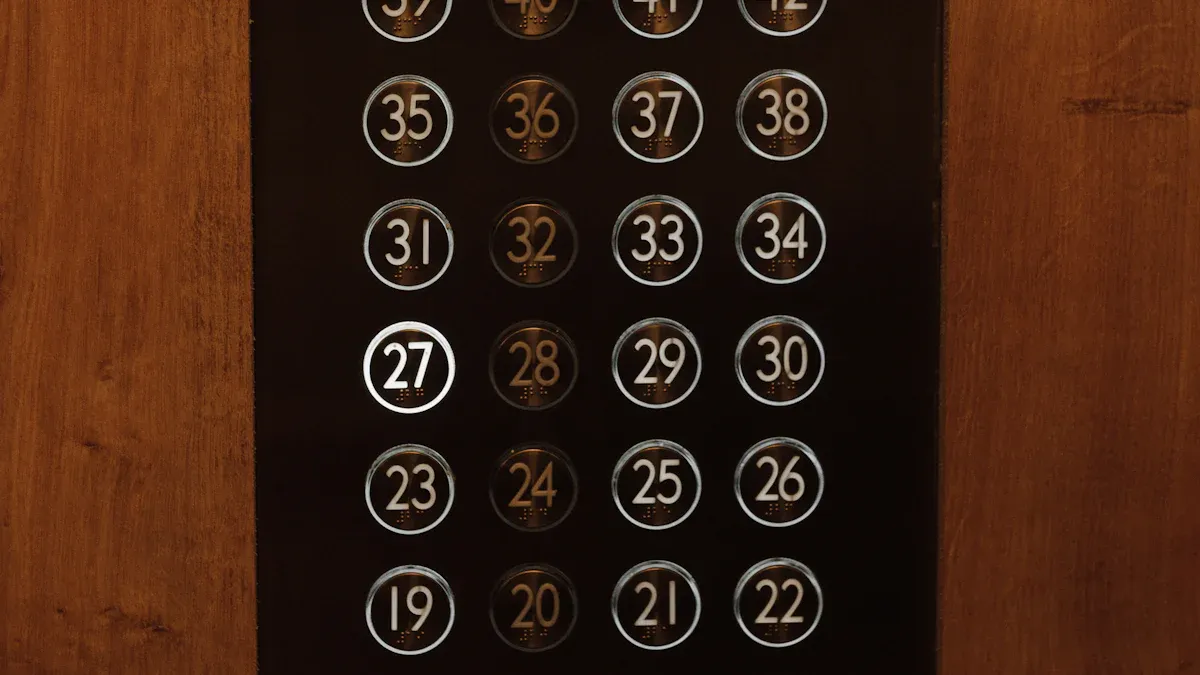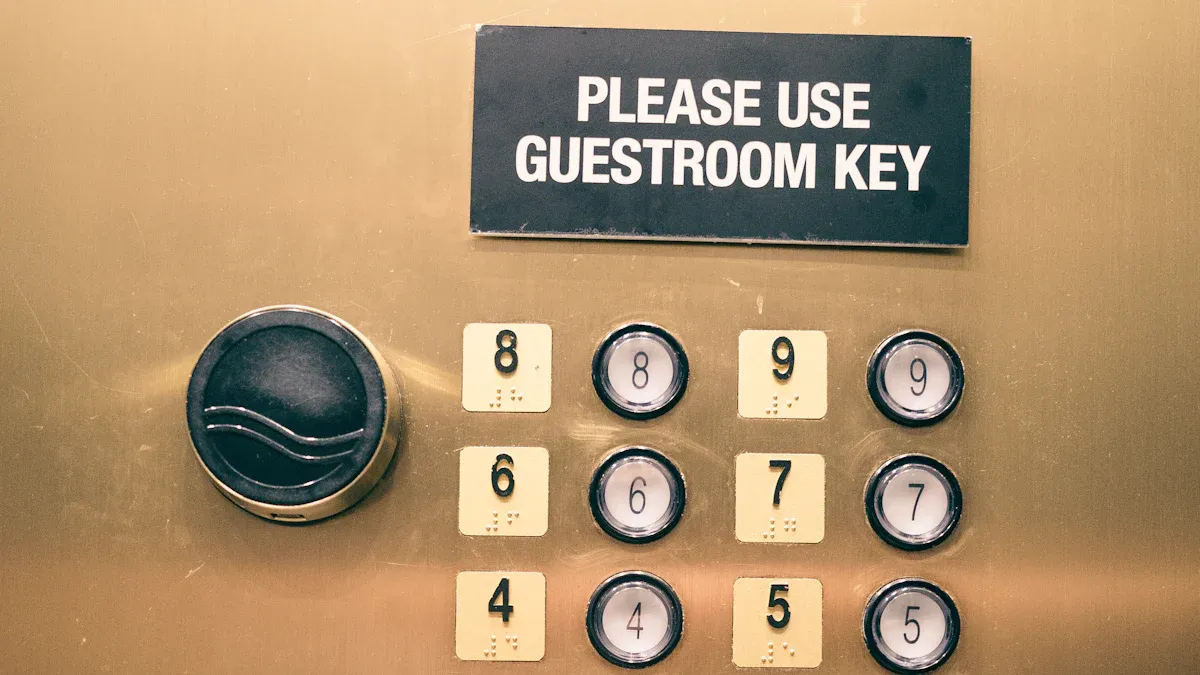
Before installing a Zinc Alloy Keypad, start by preparing the area. Clean the surface to remove dust and debris. Check for any uneven spots on the door or frame. A smooth and stable base ensures the keypad operates correctly and lasts longer. Proper preparation prevents alignment issues and guarantees secure mounting.
Tip: Use a level tool to confirm the door frame is straight before proceeding.
المداخل الرئيسية
- Clean the area and check for bumps or uneven spots. This helps the keypad fit well and stay secure.
- الاستخدام tools like screwdrivers, a drill, and a level. These tools make sure holes are correct and the keypad is straight.
- Keep your keypad clean and test if it works often. This makes it last longer and work better.
Tools and Materials for Installing a Zinc Alloy Keypad

Essential Tools for Installation
To install a Zinc Alloy Keypad, you need a few basic tools. Start with a screwdriver set that includes both flathead and Phillips screwdrivers. A power drill is also essential for creating precise holes in the door or frame. Use a tape measure to ensure accurate measurements, and keep a pencil handy for marking positions. A level tool is crucial to confirm that the keypad aligns properly.
Tip: Choose a power drill with adjustable speed settings for better control when drilling into different materials.
Required Materials for a Secure Fit
Gather the necessary materials before starting the installation. You will need screws and anchors that match the keypad’s specifications. A mounting template, often included with the keypad, helps you position it correctly. If the door is metal, consider using rubber gaskets to prevent scratches and ensure a snug fit. For wooden doors, wood filler may be useful to fix any imperfections.
Optional Tools for Enhanced Efficiency
Optional tools can make the process faster and easier. A laser level provides more precision than a standard level tool. If you’re working with electrical wiring, a wire stripper and multimeter are helpful for clean connections and testing. A cordless screwdriver can save time during assembly.
ملاحظة: While optional, these tools can significantly improve the quality of your installation.
Step-by-Step Guide to Installing a Zinc Alloy Keypad

Step 1: Preparing the Door and Frame
Start by inspecting the door and frame. Ensure the surface is clean and free of debris. Use a level tool to check if the door is straight. If you notice any uneven areas, sand them down or use a filler to create a smooth surface. This step ensures the keypad will sit flush against the door, preventing alignment issues later.
Tip: If the door is painted, check for peeling paint around the installation area. Remove it to avoid interference with the keypad’s mounting.
Step 2: Marking and Drilling Holes
Position the mounting template provided with your Zinc Alloy Keypad on the door. Align it with the desired height, typically 36 to 48 inches from the floor. Use a pencil to mark the screw holes and the area for the latch. Double-check the alignment with a level tool.
Once marked, drill pilot holes for the screws. For the latch, use a hole saw to create an opening that matches the keypad’s specifications. Work slowly to avoid splintering the material.
Safety Note: Wear safety goggles while drilling to protect your eyes from debris.
Step 3: Mounting the Keypad
Place the Zinc Alloy Keypad against the door, aligning it with the drilled holes. Insert the screws through the mounting plate and tighten them using a screwdriver. Avoid over-tightening, as this can damage the keypad or the door material.
If your keypad includes a backplate, attach it to the opposite side of the door. Ensure both sides are securely fastened and aligned.
Step 4: Wiring the Keypad
If your Zinc Alloy Keypad is electronic, connect the wiring according to the manufacturer’s instructions. Match the wires by color and secure them with wire connectors. Use a multimeter to test the connections and ensure proper voltage.
Route the wires neatly through the door to avoid pinching or damage. If the keypad is battery-operated, insert the batteries and check the power indicator.
Tip: Label the wires during installation to make future maintenance easier.
Step 5: Installing the Latch and Strike Plate
Insert the latch into the hole you drilled earlier. Secure it with screws, ensuring it sits flush with the edge of the door. Next, attach the strike plate to the door frame. Align it with the latch and mark the screw holes. Drill pilot holes and fasten the strike plate with screws.
Test the latch by closing the door to ensure it engages smoothly with the strike plate. Adjust the alignment if necessary.
Step 6: Testing and Programming the Keypad
Before finalizing the installation, test the Zinc Alloy Keypad. Enter the default code provided by the manufacturer to check if the lock mechanism works. If the keypad is electronic, test the wiring by locking and unlocking the door multiple times.
Once confirmed, program your desired access codes. Follow the user manual for instructions on setting up codes and additional features like auto-lock or temporary access.
Reminder: Keep a record of the master code in a secure location for future reference.
Troubleshooting and Tips for Zinc Alloy Keypad Installation
Avoiding Common Installation Mistakes
Mistakes during installation can lead to poor performance or even damage to your Zinc Alloy Keypad. Here are some common errors and how to avoid them:
-
Skipping Surface Preparation:
Failing to clean and level the door or frame can cause misalignment. Always inspect and prepare the surface before starting. -
Incorrect Measurements:
Misaligned holes can make the keypad unstable. Double-check all measurements and use a level tool to ensure accuracy. -
Over-Tightening Screws:
Tightening screws too much can crack the keypad or damage the door. Secure screws firmly but avoid excessive force. -
Ignoring Manufacturer Instructions:
Each keypad model has unique requirements. Always follow the user manual for specific guidelines.
Tip: Take your time during installation. Rushing increases the chances of errors.
Fixing Wiring and Alignment Issues
Wiring and alignment problems are common challenges when installing a Zinc Alloy Keypad. Here’s how you can address them:
-
Wiring Issues:
- If the keypad doesn’t power on, check the connections. Ensure wires are securely attached and match the color codes.
- Use a multimeter to test for proper voltage. Replace damaged wires if necessary.
- For battery-operated keypads, confirm the batteries are installed correctly and have sufficient charge.
-
Alignment Problems:
- If the latch doesn’t engage smoothly, adjust the strike plate. Loosen the screws slightly and reposition it until the latch fits perfectly.
- For uneven doors, use shims to create a level surface for the keypad.
Note: Regularly inspect the wiring and alignment after installation to prevent long-term issues.
Ensuring Proper Functionality After Installation
Once the installation is complete, verify that the Zinc Alloy Keypad functions as intended. Follow these steps to ensure everything works smoothly:
-
Test the Lock Mechanism:
Lock and unlock the door multiple times using the keypad. Check for any resistance or unusual sounds. -
Verify Access Codes:
Program and test all access codes. Ensure each code works correctly and provides the desired level of access. -
Inspect the Latch and Strike Plate:
Close the door and observe how the latch engages with the strike plate. Adjust if necessary to ensure a secure fit. -
Check Additional Features:
If your keypad includes features like auto-lock or temporary access, test them to confirm proper functionality.
Reminder: Keep the user manual handy for troubleshooting and future reference.
Maintenance Tips for Zinc Alloy Keypads
Cleaning and Protecting the Keypad
إبقائك Zinc Alloy Keypad clean ensures it remains functional and visually appealing. Use a soft, damp cloth to wipe the surface weekly. Avoid harsh chemicals or abrasive materials, as they can damage the keypad’s finish. For stubborn dirt, mix a small amount of mild soap with water and gently clean the area.
Tip: Apply a silicone-based spray to the keypad once a month. This creates a protective layer that resists moisture and prevents corrosion.
Preventing Wear and Tear
To extend the life of your keypad, handle it with care. Avoid slamming the door, as this can loosen the mounting or damage internal components. Teach all users to press the buttons gently to prevent unnecessary wear.
Inspect the keypad and its surrounding hardware regularly. Tighten any loose screws and check for signs of rust or damage. If you notice any issues, address them immediately to avoid further complications.
Reminder: Keep the keypad away from direct sunlight or extreme temperatures. These conditions can weaken the material over time.
Regular Testing and Updates
Test your keypad monthly to ensure it operates smoothly. Enter access codes and check the locking mechanism. If the keypad is electronic, replace the batteries as soon as the power indicator shows a low charge.
For advanced models, update the firmware periodically. Manufacturers often release updates to improve security and functionality. Refer to the user manual for instructions on downloading and installing updates.
ملاحظة: Always keep a backup of your access codes in case you need to reset the keypad during updates.
Installing a Zinc Alloy Keypad becomes straightforward when you follow the outlined steps. Preparing the surface, aligning components, and testing the lock ensure a secure fit and reliable performance. Regular maintenance, like cleaning and testing, keeps the keypad functional for years. Use this guide to achieve a professional installation and long-lasting results.
FAQ
What is the ideal height for installing a Zinc Alloy Keypad?
Position the keypad 36 to 48 inches from the floor. This height ensures accessibility for most users and complies with standard ergonomic guidelines.
Tip: Use a level tool to confirm proper alignment during installation.
Can I install a Zinc Alloy Keypad on a metal door?
Yes, you can install it on a metal door. Use rubber gaskets to prevent scratches and ensure a snug fit.
How often should I replace the batteries in an electronic keypad?
Replace the batteries every 6 to 12 months. Check the power indicator regularly to avoid unexpected lockouts.
Reminder: Always keep spare batteries nearby for emergencies.


